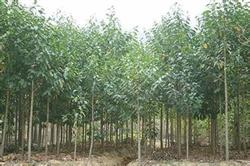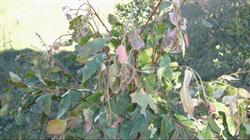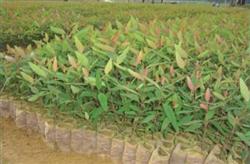Planting techniques of Eucalyptus

Eucalyptus belongs to the genus Eucalyptus of Myrtle family, which is native to Australia. It is mainly planted in Yunnan, Guangdong, Guangxi and western Sichuan provinces in China. There are five kinds of Eucalyptus urophylla, Eucalyptus globulus, Eucalyptus lemon, Eucalyptus grandis and Eucalyptus cantonensis. Eucalyptus leaves can extract eucalyptus oil (aromatic oil), leaves and essential oils can be used as medicine, which has the effects of anti-inflammation and sterilization, invigorating stomach, expectorant and expelling wind. Wood has fine quality and corrosion resistance, and heartwood is resistant to termites, which is widely used in construction, bridges, shipbuilding, wharf, papermaking, mines, livestock sheds, fuel and other industries, with remarkable economic and ecological benefits. With the large-scale development of the western region and the implementation of the Yangtze River and Pearl River shelterbelt projects, the progress of returning farmland to forests has been accelerated, and the planting area of eucalyptus has been gradually expanded and the prospect is promising. 1. Suitable environment Eucalyptus likes warm climate, but does not bear hot and humid climate, and overheated climate grows poorly; Yunnan is mainly distributed in the area of 1200-2400 meters above sea level, and it can only withstand the low temperature of-7 ℃ for a short time. If it is menstruated under-5 ℃ for 2-3 days, it will produce varying degrees of freezing injury, the light twigs will die, the heavy ones will die. Eucalyptus is light-loving, and a little shade can affect the growth rate. Like fertile and moist acid soil. In a good environment in Kunming, the seedlings can reach 1.5-2 meters high in 1 year, 9 meters in 3 years old, 20 meters in 10 years old, 30 meters in 20 years old, grow slowly later, blossom and fruit at 6 years old, and enter the full fruit stage 15 years later. Second, sowing seeds from November to December and sowing in spring the following year, or from July to August, sowing seeds in the same year. 1.5 kg of seeds can be obtained per 100 kg of fruit, 2.8 g of 1000-grain weight of Eucalyptus globulus and 1.5 g of Eucalyptus grandis, and the seed germination rate is more than 90%. 1. Raising seedlings in mother bed. Choose the vegetable garden with fertile soil as the seedling bed, sow in the middle of March, fine soil preparation, soil moisture width of 1.2-1.6 meters. Soak the seeds for 48 hours, mix the seeds with fine sand and sow them on the seedling bed and cover them with fine dung soil 1-2 cm thick. Cover the film after pouring enough water, and it can be unearthed 7-10 days after sowing, keeping the soil moist and ventilated to prevent high temperature burning of seedlings. When the seedlings grow to 5-10 cm high, uncover the film to refine the seedlings; when the seedlings grow to 30-40 cm high, it is appropriate to choose overcast and rainy days to transplant, easy to survive. Transplanting is the best in central Yunnan from early June to early July. 2. Raising seedlings in nutrition bag. After bagging the nutritious soil, sow the soaked seeds in the bag (2-3 seeds in each bag), then cover a layer of fine dung, pour enough water and cover the film, pay attention to ventilation and keep moisture. Set the seedling during the seedling growth period, pull out the weak seedling, and leave 1 plant in each nutrition bag. When the seedlings grow to 10-20 cm high, they can be transplanted, generally raising seedlings in early March and transplanting in the rainy season in early June. 3. Seedbed management. After the seedlings emerge, pull out all the weeds in the seedling bed. Eucalyptus seedlings are prone to Rhizoctonia solani. At the initial stage of the disease, 70% dicarpine 500 times solution per mu (100 kg per mu) was sprayed or sprinkled on the seedbed 2-3 times, with an interval of 10-15 days each time. Transplanting and young tree management 1. Transplanting. Transplanting was carried out after the rainy season began in early June, with a pond depth of 40 cm and a diameter of 40 cm, with 300 plants per mu (1 × 2 m between rows). After planting, the fixed root water was poured enough to cultivate the soil above the surface to prevent stagnant water and soil consolidation, which was beneficial to the survival and growth of young trees. 2. Fertilization and pest control. After survival, 50 kg of compound fertilizer or 40 kg of common calcium superphosphate and 10 kg of urea were applied around the pond. Eucalyptus is vulnerable to yellow ants. After transplanting, 500 grams of 10% diazinon granules or 1 kg of 3% phoxim per mu are mixed in chemical fertilizer and mixed well with the soil around the pond to prevent the harm of yellow ants. 3. Young tree management. After survival, the young forest should forbid grazing, shovel and hoe the weeds around the seedlings in time, loosen the soil conditionally and keep the soil loose. After the seedlings have grown for 2-3 years, pruning is carried out once a year to remove the thin and weak branches in the lower layer, which is beneficial to ventilation and light transmission and maintain the growth of the seedlings. The aromatic oil can be extracted from leaves after 4 years. To sum up, the cultivation of strong seedlings and the management of young trees 1-2 years after transplanting are very important in the cultivation and management of eucalyptus, and the management after the third year is mainly pruning branches and cultivating trunk into wood. Therefore, the economic, ecological and social benefits of planting eucalyptus are very significant and have broad prospects.
- Prev

Remedial measures for frozen eucalyptus trees
The main manifestation of freezing injury of eucalyptus is frozen tip, and severe aboveground parts freeze to death. The severity of freezing injury varies according to eucalyptus variety and forest age. Eucalyptus urophylla, Eucalyptus grandis and Eucalyptus Dunn are the more cold-tolerant species of Eucalyptus, while Eucalyptus urophylla and Eucalyptus urophylla have poor cold tolerance. The main anti-freezing technical measures are: 1, slight frost injury (top tip.
- Next

Seed collection, seedling cultivation and afforestation techniques of eucalyptus
Eucalyptus is a world-famous fast-growing tree species with strong adaptability, diverse wood species, wide use and high economic value. it is not only a timber tree species, but also a road, garden and windbreak tree species. At present, eucalyptus afforestation covers 15 provinces in southern China, mainly distributed in Guangdong, Guangxi, Fujian, Jiangxi, Sichuan, Yunnan and so on.
Related
- Fuxing push coffee new agricultural production and marketing class: lack of small-scale processing plants
- Jujube rice field leisure farm deep ploughing Yilan for five years to create a space for organic food and play
- Nongyu Farm-A trial of organic papaya for brave women with advanced technology
- Four points for attention in the prevention and control of diseases and insect pests of edible fungi
- How to add nutrient solution to Edible Fungi
- Is there any good way to control edible fungus mites?
- Open Inoculation Technology of Edible Fungi
- Is there any clever way to use fertilizer for edible fungus in winter?
- What agents are used to kill the pathogens of edible fungi in the mushroom shed?
- Rapid drying of Edible Fungi

